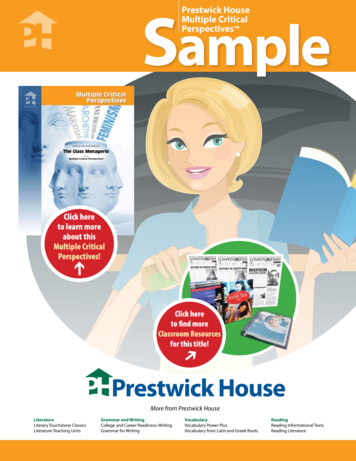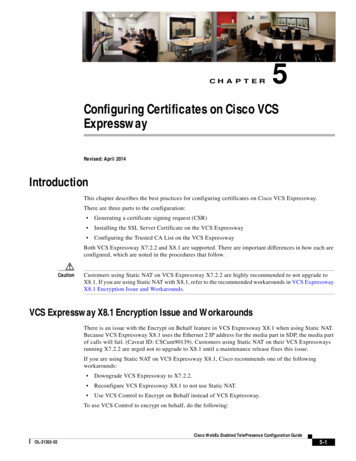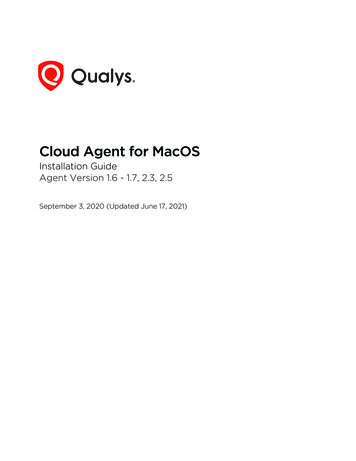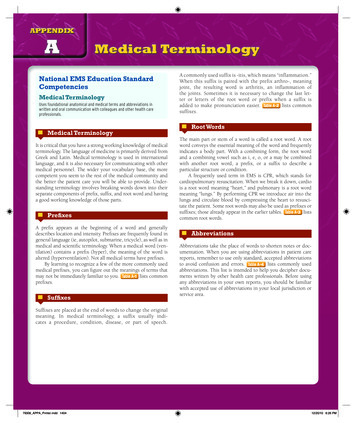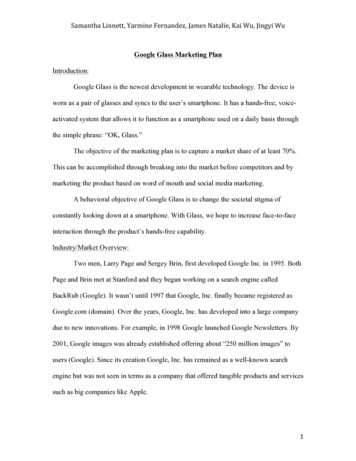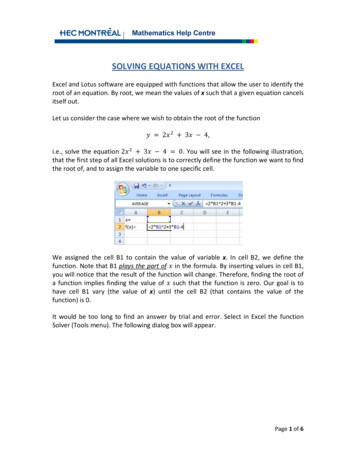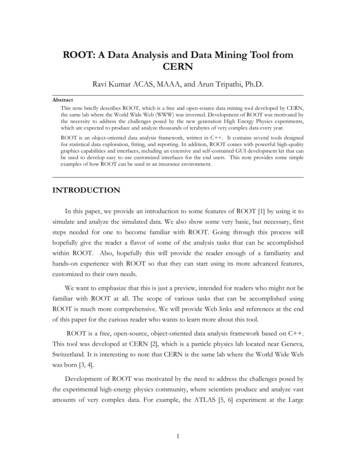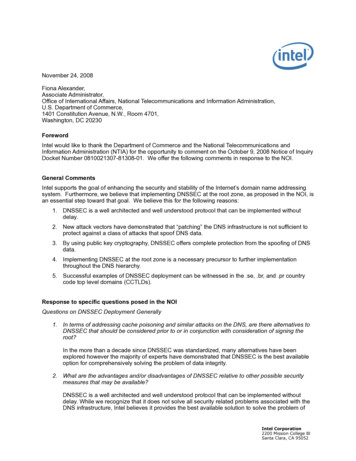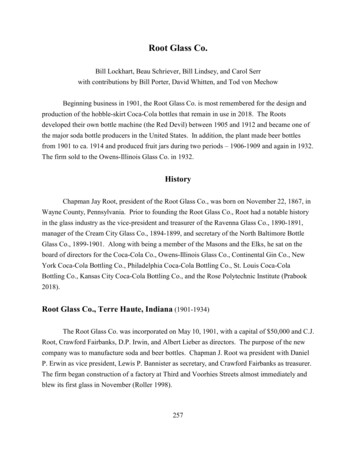
Transcription
Root Glass Co.Bill Lockhart, Beau Schriever, Bill Lindsey, and Carol Serrwith contributions by Bill Porter, David Whitten, and Tod von MechowBeginning business in 1901, the Root Glass Co. is most remembered for the design andproduction of the hobble-skirt Coca-Cola bottles that remain in use in 2018. The Rootsdeveloped their own bottle machine (the Red Devil) between 1905 and 1912 and became one ofthe major soda bottle producers in the United States. In addition, the plant made beer bottlesfrom 1901 to ca. 1914 and produced fruit jars during two periods – 1906-1909 and again in 1932.The firm sold to the Owens-Illinois Glass Co. in 1932.HistoryChapman Jay Root, president of the Root Glass Co., was born on November 22, 1867, inWayne County, Pennsylvania. Prior to founding the Root Glass Co., Root had a notable historyin the glass industry as the vice-president and treasurer of the Ravenna Glass Co., 1890-1891,manager of the Cream City Glass Co., 1894-1899, and secretary of the North Baltimore BottleGlass Co., 1899-1901. Along with being a member of the Masons and the Elks, he sat on theboard of directors for the Coca-Cola Co., Owens-Illinois Glass Co., Continental Gin Co., NewYork Coca-Cola Bottling Co., Philadelphia Coca-Cola Bottling Co., St. Louis Coca-ColaBottling Co., Kansas City Coca-Cola Bottling Co., and the Rose Polytechnic Institute (Prabook2018).Root Glass Co., Terre Haute, Indiana (1901-1934)The Root Glass Co. was incorporated on May 10, 1901, with a capital of 50,000 and C.J.Root, Crawford Fairbanks, D.P. Irwin, and Albert Lieber as directors. The purpose of the newcompany was to manufacture soda and beer bottles. Chapman J. Root wa president with DanielP. Erwin as vice president, Lewis P. Bannister as secretary, and Crawford Fairbanks as treasurer.The firm began construction of a factory at Third and Voorhies Streets almost immediately andblew its first glass in November (Roller 1998).257
In an expansion, Root bought Harry W. Streeter’s idle Terre Haute Glass Mfg. Co. at 17thSt. and Maple Ave. in October 1905 and entered fruit jar manufacture early the following yearwith seven machines in operation. A group headed by Streeter had incorporated the Terre HauteGlass Mfg. Co. on January 20, 1900, and made the first fruit jar, the only product made at theplant, on July 16 of the same year (Roller 1994:106). Although Root later developed its ownsoda bottle machine, the plant used Miller machines for making fruit jars. The fruit jar operationwas short lived. The Ball Brothers bought the factory on November 9, 1909, and made jars thereuntil the company closed the operation in 1914 (Brantley 1975:26; First National Bank 2001;Jones 1964:[25]; 1965:[24]; National Glass Budget 1909:1; Robbins 2007; Roller 1994:104,106; 1998; Toulouse 1971:445-447).The Root Glass Co. is best remembered by most people for its development of theoriginal “hobble-skirt” Coca-Cola bottle in 1915. The bottle was designed by Earl Dean,foreman of the mold shop (First National Bank 2001; Jones 1964:[25]; 1965:[24] Bristow1917:13). For a complete story of the design, see Hobson (2002:4), partly reprinted in Lockhart& Miller 2008:101).However, the company is important for a lesser-known invention as well. According toToulouse (1971:445-446), “Beverage bottles were . . . handmade until about 1912,” the year thecompany began to produce all its soft drink bottles on its own semi-automatic bottle machines.The plant began work on the machines in 1905 and used the developing models to make somebottles. In 1910, a correspondent informed the Commoner and Glassworker that “the Unitedmachine at the Root plant is said to be doing well on beer bottles.” (Idlewild 1910:16).Apparently, however, full implementation of the new machine, known as the “Root Machine” orthe “Red Devil,” was not affected until ca. 1912.By 1913, the company used both semiautomatic machines and mouth-blown production1to make “beer and water [i.e., soda]” bottles on three continuous tanks with 26 rings (Journal of1This statement contradicts the Toulouse claim that “all” bottles were made by machineby 1912. Because of the sheer volume of orders, it is almost certain that the transition periodexisted. During this time, machines handled the bulk of production, but overload orders,especially small ones, were mouth blown. This transition period probably extended from ca.1906 or 1907 to ca. 1914 or later.258
Industrial and Engineering Chemistry 1913:952). Bill Porter (personal correspondence12/1/2010) reported a mouth-blown, straight-sided Coke bottle with a ROOT logo and date codefor 1914, so hand methods were in use at least that late. The entire complex was flattened by atornado on March 23, 1913, but Root soon rebuilt (First National Bank 2001; Glass Industry1925:136).The Root Glass Co. was listed from 1907 to 1921 as making “Beer, Soda, [and] Liquor”bottles (Thomas Publishing Co. 1907:158; 1917:730; 1918:809; 1920:826; 1921:780). This isthe only reference to liquor bottles we have found in the literature, and we have yet to discover asingle liquor bottle bearing the ROOT mark. We can speculate that Root intended to make a lineof liquor bottles fairly early in its production sequence, but the total orders for beer and soft drinkbottles eliminated the need. We have frequently documented continued listings by the ThomasRegisters for several years after products were discontinued or even after factories were closed.In 1917, the plant operated three tanks. No. 1 tank was “worked with six one-manO’Neill machines.” Tank No. 2 used “four United machines, one one-man Teeple machine andtwo one-man O’Neill machines.” The final tank operated “five one-man Teeple, two one-manMiller and one one-man O’Neill machines.” The plant made beer and Coca-Cola bottles(Bristow 1917:13). Root may have only added colorless glass in 1919. An October 1918 articlestated that “new lines of ware [for Root] for 1919 include flint bottles and jars.” This alsosuggests that Root wanted to reenter the jar field in that year (Glass Worker 1918:13).By 1921, Root offered bottles in “light green, flint, or amber” colors until November1925 when the plant added emerald green – the color of Seven-Up bottles, also called ForestGreen in some studies (Glass Container 1925:32). The plant only made bottles to order, ratherthan storing up generic styles. Beer bottle production may have been discontinued as early as1914 (see ROOT discussion below) but was certainly gone with the advent of Prohibition in1920. A March 1926 ad (Glass Container 1926:28) noted:Three furnaces, 22 bottle making machines and a greatly increased force of menare “going it” day and night at the Root plant to give you the “rush” service.Almost any size order can be made up and shipped within 48 hours of its receipt,if necessary. Nothing sidetracks your order–we make Beverage Bottlesexclusively. . . . Licensed Mfrs. of all Patented Design Beverage Bottles.259
The term Patented Design Beverage Bottles refers to the specialty or proprietary sodabottles that were popular with many of the national soda brands during mid-1920s to late 1930s.Most local bottlers used generic, paper-labeled bottles until ca. 1925, when they joined thespecialty bottle craze of the national brands. Root was a pioneer in the specialty bottle field. ANovember 1921 Root ad showed 13 specialty styles, including the well-known hobble-skirtCoca-Cola bottles and those from Whistle, Orange Crush, Chero-Cola, and a particularlyelaborate design for Bludwine. By the late 1930s to early 1940s, these styles were mostlyreplaced by Applied Color Label bottles.The Glass Industry (1925:136) noted that Root operated three plants at Terre Haute by1925, although this may have referred to the three furnaces noted earlier. On May 15, 1925,plant No. 2 was destroyed by fire. Although plant No. 3 had been similarly burned in November1924, it had been rebuilt. By 1927, the company made “flint, green, amber and emerald greenbeers, beverage bottles, minerals, packers and preservers” by machine at three continuous tankswith 16 feeders (indicating that plant No. 2 had been rebuilt). The listing remained the sameuntil 1933, when the plant was “now Owens-Illinois Glass Co.” (American Glass Review1927:143; 1933:71).Apparently, Root reestablished fruit jar manufacture during its final year of independentoperation (1932). The Hollieanna Mason was embossed “ROOT” on its base. An identical jarwas made by Owens-Illinois (with the Diamond OI logo above a ghosted ROOT logo on thebase) from ca. 1933 to ca. 1939 (Caniff 2008:7-8; Roller 1983:157). Creswick (1987:63) alsoillustrated the Hollieanna MASON with ROOT / 32 embossed on the base.Root became Plant No. 25 of the Owens-Illinois Glass Co. in 1932. Although Toulouse(1971:447) maintained that the company retained the Root name for the next two years, empiricalevidence questions that period. Date codes to “32” are reported in association with ROOTheelmarks, but we have not seen any past that date. At least one Hollieanna Mason jar (seesection below) was made with “ROOT” peened out on the base and the Owens-Illinois logo anda “3” (1933) date code added. This suggests that the Root name was phased out by the yearfollowing the purchase. Some bottles may have been embossed with “ROOT 33” to fill existingcontracts or to wear out existing molds, although we have not yet found an example.260
The factory continued to produce glass until 1938 when Owens-Illinois shut it down. Itwas reactivated in 1942 but was again idled in 1948 and used as a warehouse when not active(Ayres et al. 1980:37; Roller 1994:104; Toulouse 1971:445-447). After the sale to OwensIllinois, the Root company became an investment concern (Hopson 2003:7; Jones 1965:[24]).The American-Wheaton Glass Co. purchased property in 1960, then destroyed the formerplant to build a new factory. The American Can Company acquired the Wheaton Plant in 1962,and created a subsidiary called A-W Glass. The Midland Glass Company purchased the complexin January of 1968, and the Anchor Glass Container Corp. finally acquired the factory thenclosed it in 1984. A decade later, Anchor razed the buildings (First National Bank 2001; Hopson2003:7).Containers and MarksRGCO (1901-ca. 1907 – possibly as late as 1912)The “RGCO” logo appears on the bases or heels of a largenumber of soda bottles made during the 1901-1910 period(Figure 1). The very few examples we have seen always have acapital “O” in “CO” and no punctuations. In descriptions fromresearchers, however, the mark was described with either acapital or lower-case “O” as well as with or without punctuation.Figure 1 – RGCo (Bill Porter)Various researchers have proposed a total of four possible glass houses as the user of the“RGCo” mark on beer and soda bottles, as well as a single packers’ bottle used by W.H.Hutchinson & Son, Chicago, Illinois. Toulouse (1971:440) claimed that the RGCo mark wasused by the Renton Glass Co., Renton, Washington, from 1907-1911 – almost certainly zeroingin on the only glass house he knew about with the correct letters. Peters (1996:9) and Whitten(personal correspondence 8/11/2004) both vehemently opposed the Renton hypothesis, notingthat the bottlers using “RGCO” and “ROOT” bottles were mostly in the Midwest, extending intothe East and Southeast – very unlikely venues for a Washington state glass house. In addition,Renton was a small plant that could not have produced the sheer quantity of bottles with the“RGCo” mark.261
Kroll (1972:3) noted that the R.G.Co. mark was “most likely associated with Reed [i.e.Eugene P. Reed Co.], but could have been the Root Glass Co. Since the various Reed glasshouse incarnations have a well-defined sequence of marks (see F.E. Reed section), no otherresearchers have seriously considered Reed as a possibility.In the late 1990s, the Bottle Research Group discovered the Randall Glass Co. atMorgantown, West Virginia, open from 1903 to 1907 – virtually the perfect time period for thelogo. However, like Renton, the factory was small, an unlikely venue for the huge number ofbottles with the “RGCo” mark. The major problem, however, is that some soda bottlersenumerated by Peters (1996) did not begin production until 1908, 1909, and 1912, respectively.Since each of these companies used bottles with RGCo marks, those could not have been madeby Randall, since Randall had to have been closed for one, two, or five years prior to the openingof these plants. Unless Peters’ dates are completely out of sync (which is unlikely), this soundsthe death knell for the Randall Glass Co. as a possibility.The final proposal – almost certainly the correct one – was the Root Glass Co. Peters(1996:9) more solidly supported the Root hypothesis, noting that “R.G.CO. bottles made forWisconsin bottlers are identical to (later) ROOT bottles used by the same bottler. Examples arenumerous. . . . R.G.CO. Hutchinson soda bottles used by these bottlers were blown in the samemolds as ROOT marked sodas.”In a personal communication (10/28/2004), Peters further justified his claim:There was a change in how Root marked their soda water bottles about 1909. Atthat time they went from using RGCO to ROOT. The ROOT bottles are blown inthe same molds as the RGCO bottles. Aside from RGCO vs. ROOT the bottlesare identical in every respect. There are other more subtle similarities amongRGCO and ROOT bottles, such as similarities in colors, finishes (Root had“flared” Hutchinson blobs), bottle design, and emboss[ed] lettering size and style.(The emboss[ed] lettering size and style is a dead giveaway on many Root bottles- you can pick out a Root bottle without knowing it’s actually from Root.)Whitten (2018a) and van Mechow (2018) both also credited the Root Glass Co. with theuse of the mark and further pressed the regional perspective. Root ads as late as 1924 showed a262
logo that had “R-G-Co” in an elongated diamond,often incorporated into the double “o” in Root (e.g.,Glass Container 1924:46). While this diamond logowas never embossed on bottles, the use of the initialsshows that the company did consider the initialssignificant (Figure 2).There are some interesting generalities thatfit both RGCo and ROOT bottles. Both wereFigure 2 – RGCo ad (Glass Container 1924:46)embossed on bases during the early period (notincluding Hutch bottles). Both occasionally had a single-digit code (so far no higher than 6 forRGCo; 5 for ROOT), also on the bases. Multiple-digit numbers (almost certainly mold codes)for both were embossed on the heels.In conclusion, RGCo was used by the Root Glass Co. from the beginning of the companyin 1901 to ca. 1906 or 1907. Because virtually all glass houses continued to use molds until theywore out, some bottles with the RGCo mark were probably made as late as 1912.RGCO on Coca-Cola BottlesThe famous hobble-skirt Coca-Cola bottle, patented in 1915, almost certainly the parentof a generation of bottles called specialty bottles by the industry and often now referred to asproprietary bottles by archaeologists and deco bottles by collectors. The earliest specialty bottleswe have discovered were used about the turn of the century, although the trend really followedthe invention of the Coke bottle. Some brands adopted specialty bottles ca. 1920, although mostused generic bottles with paper labels until the mid-1920s or later. Specialty bottle use did notbecome general until ca. 1925. Coca-Cola and Dr Pepper were notable hold outs at the end ofthe period, continuing to use specialty bottles into the 1960s. Coke even retained the hobbleskirt bottle style and added ACL lettering.Taking a different tack from other researchers, Porter (2012) hypothesized that the threedigit numbers accompanying the “RGCO” marks on Coke bottles (and others) were mold, model,or proprietary numbers and were used in sequential order, forming an ordinal scale that could beused as a rough dating formula. Although most of the “RGCO” logos were applied to the bases,263
the mold codes are found on the heels. Porter further noted that when Coca-Cola bottlingfranchises used both Hutchinson-finished and crown-finished bottles, they were sequentiallynumbered, consistently with the crown-finished bottle first. For example, the crown bottle forthe Birmingham, Georgia, franchise was numbered “404,” while the Hutchinson bottle bore“405.” Dennis Smith (see Whitten 2018b) continued Porter’s research into the numbers, andboth hope to create dating guides for Root bottles based on the mold codes.Although Porter’s reasoning is not pertinent to this study, he determined that the earliestCoke bottles made by Root appeared on “straight-sided” examples in 1905, and these carriedmold numbers in the 300s (as low as 315). He noted that Fowler (2018) showed numerousHutchinson soda bottles with much lower numbers and suggested that most of these were madeprior to the 300-series Coke bottles. By the time Root began using date-coded heelmarks in1909, the numbers were into the 1100s. The “RGCo” initials were phased out as early as threeyears before the date code system began (Porter 2012).Hutchbook (Fowler 2018) provided a list of 515 Hutchinson soda bottles, almost allmarked on the heels (a few on the bases) with either “RGCO” or “ROOT.” Mold numbersranged from a low of 10 to a high of 801, although the vast majority fell between the 60s and350s. Two interesting marks were “RGCo No.7” and “No. 8.” Although this is uncertain, thesecould be date codes for 1907 and 1908. If so, Root dropped the “No.” in 1909. Two odditieswere “RGCo 63 11” and “RGCo S-7.” See below for data on “ROOT” logos on Hutchinsonbottles.Although the system is not perfect, it is clear that bottles with the lower mold numbersare older than those with higher ones – and this continues into the date code era (1909-1932).Some use of older numbers occur on newer bottles, probably because some firms continued touse the same model of bottle, so Root maintained the molds until they completely wore out. Inaddition, a replacement mold may have sported the same number as the older one it replaced.ROOT (ca. 1906-1932)Virtually all researchers of 20th century bottles identified the ROOT mark as belonging tothe Root Glass Co. from 1901 to the early 1930s. After the transition from the RGCo mark, all264
bottles made by the Root Glass Co. seem to have been marked with ROOT embossed on eitherthe base or heel, and jars had either basemarks or cursive embossing on the front body. The useof the cursive “Root” on fruit jars began in 1906, and it is likely that block “ROOT” was firstused on bottles during that same year. Our findings are limited to fruit jars, soft drink and beerbottles – the only types of containers we have found with Root marks.Toulouse (1971:445) maintained that the plant made “a general line of ware” thatincluded “drugs, chemicals, sodas, waters, and beers,” although ads and listings fail to supportthis claim until very late in the life of the company. A single source asserted that Root madeliquor bottles, but we have found no evidence to support such manufacture. Each of the threemajor container types requires its own discussion.Fruit Jars (1906-1909)According to Toulouse (1971:445), the company marked itsfruit jars with a slight upwardly slanted, cursive “Root” underlinedby an extension from the base of the “t” (Figure 3). He dated themark 1901 to 1909 despite the fact that the fruit jar factory did notopen until 1906.Roller (1983:308; 2011:451) showed the slanting cursiveRoot mark on Mason jars made of yellow green or light blue glassand noted a variation with a “1" high R in center of base.” He datedthe jars ca. 1906-1909. The jars were accompanied by zinc lidsembossed “ROOT GLASS COMPANY” in a circular format on theinner section of the top (Figure 4). Creswick (1987:113) noted twovariations of the ROOT MASON (one with curls in each “o” andFigure 3 – Root (NorthAmerican Glass)one with no curls) and included an illustration of the GENUINEZINC CAP.Toulouse (1969:263-264) had earlier noted a finer distinction than either Roller orCreswick, which added another dichotomy. The first of these was mouth blown, and he datedthose 1902-1909. The second, however, was “crudely machine-made.” He noted that Root haddevised a semi-automatic bottle machine just before selling out to Ball Brothers. The last jars265
were made on the machine from 1908 to1909. In addition, the machine-madejars were manufactured with and withoutthe word MASON below “Root.”According to Roller (1994:106),however, the plant was “beingoverhauled and equipped withmachines” during February 1906. As ofFigure 4 – Zinc lid (North American Glass; Roller 1983:308)March 24, the plant had sevenmachines, three making half-gallonjars, three for quarts, and one forpints. In 1909, the plant used Millermachines with Miller’s AutomaticPatent Attachment. Creswick(1987:63, 113) also showed thecursive Root MASON in twovariations. Long-time jar collectorand researcher Tom Caniff statedthat he had never seen a mouthblown Root jar, although he added,Figure 5 – “Rall” Mason (North American Glass)“of course, you never know . . .”(personal communication 11/24/2008). It seems veryunlikely that mouth-blown jars of this type exist.After the Ball Brothers acquired the fruit jar plantin 1909, they altered the older Root molds to form theword “Ball” in cursive. The quality of the altered moldsvaries, but most clearly show a “B” where the “foot” of theletter “R” has been turned back toward the front of theletter (i.e., to the left). Collectors frequently call these“Rall” Mason jars (Figures 5 & 6). They were made at theformer Root plant from 1909 to 1913, when Ball closedthe factory. In 1910, however, Ball shipped some of the266Figure 6 – “Rall” Mason (Creswick1987:20)
altered molds to the Coffeyville, Kansas, plant, and these weremade in colors ranging from light yellow green through brightolive green. Although the vast majority of these jars had theolder shoulder-seal finish, at least one mold was furthermodified to form a bead-seal finish (Brantley 1975:24;Creswick 1987:20; Kath 1998:43; Roller 1983:38).Hollieanna Mason Jars (1932)Root made the Hollieanna Mason jars for Hollie andAnna Oakley, owners of the Oakley grocery chain in 1932.Figure 7 – Hollieanna Mason(Creswick 1987:63)The chain began ca. 1910and grew until 1939, when the Oakleys sold their stores to theKroeger chain. The jars were embossed “HOLLIEANNA(cursive, slight arch) / MASON (block, horizontal)” on the sideand “ROOT (underlined) / 32” on the base (Figure 7). OwensIllinois continued making the jars, peening out the “ROOT /32” and embossing “25 {Owens-Illinois logo} 3 / 8” above theold mark (Caniff 2008:7-8; Creswick 1987:63-64 – Figure 8).Roller (1983:157) suggested that the jars continued to beFigure 8 – Hollieanna basemanufactured by Owens-Illinois until ca. 1939.Soft Drinks Bottles (1906-1932)The ROOT mark, embossed on the bases, was likelyfirst used in 1906, the year that Root adopted the cursive Rooton fruit jars. The early marks fell into two patterns. The firstwas a heelmark followed by a 2- to 4-digit mold code (Figure9). This placement was initially only placed on Hutchinsonstyle bottles. Although Hutchinson bottles were sometimesFigure 9 – Early heelmark (Bill Porter)used for beer, they were mostly considered soda bottles.We presented a brief study of data from Hutchbook (Fowler 2018) in the “RGCO”section above, and it is also appropriate to this discussion. As with “RGCO,” the “ROOT” logo267
was almost always placed on the heel, and theaccompanying mold numbers ranged from a low of199 to a high of 1287 – although the vast majoritywas in the 360-600 range. A single bottle wasembossed “ROOT 232 08,” and two were embossed“ROOT 604 09,” suggesting that these were datecodes for 1908 and 1909. Others had date codesranging from “1199 ROOT 10” to “1199 ROOT 13”Figure 10 – Basemark (eBay)(1910-1913), suggesting that the use of Hutchinsonsoda bottles was phasing out during the 1910-1913 period (note the oddity that both of these hadthe same mold code). A single outlier was embossed “ROOT 33 18” – showing that Root used avery old mold number on a Hutchinson bottle produced in 1918 – long after the “accepted” datefor the Hutchinson phase-out date of 1912.The second placement of marks was on the bases of crown-topped soda bottles. Theseincluded “ROOT” with no numerical codes (Figure 10) andthose with single-digit numbers below the mark (e.g.,ROOT / 2). At some point (probably 1909), the markshifted entirely to the heel. These heelmarks had two setsof numerical codes. One set of numbers, almost certainly amold code, ranged from two to four digits (Figure 11). Asmay be expected with codes representing available models,the earlier ones comprised lower numbers. For example,the highest code we have seen on Hutchinson bottles isFigure 11 – Later heelmark (Bill Porter)1287, although typical numbers for those bottles are in 300600 range or lower. Numbers in the 3000s (in our sample) do not appear until the 1920s.Prior to the introduction of date codes, the mark (ROOT) preceded the mold number onheelcodes. With the advent of date codes, however, the codes and manufacturer’s mark couldappear in any order on the heel, e.g.:1116 ROOT 9 (mold ROOT date)711 13 ROOT (mold date ROOT)14 670 ROOT (date mold ROOT)268
Our sample does not include any examples where “ROOT” precedes the mold number,when the date code is present. By ca. 1920 (possibly a bit earlier), Root had adopted a steadypattern with the mold code was to the left of “ROOT” and the date code was to the right (e.g.,1430A ROOT 20).Porter (1996:3) noted that dating began on Root bottles in 1909. An El Paso examplesupports Porter’s claim that the “9” is a date code. The El Paso bottle is the second style used bythe Magnolia Bottling Co. The company was founded in late 1907 or early 1908 and used a tallbottle with a very rounded heel for its first drinks. The second style came in five variations, eachmouth blown. All used plates except the first one marked 1116 ROOT 9.2 The date of 1909 fitsperfectly in the sequence of bottles used by Magnolia (Lockhart 2000).The use of heelmarks on soda bottles, therefore, likely extended from1909 to the purchase of the company by Owens-Illinois in 1932.Toulouse (1971:446) noted that Owens-Illinois retained theRoot company name until 1932, and that is the latest date code we havefound. This suggests that although Owens-Illinois may have maintainedthe name for advertising, bottles were probably all marked with theDiamond-Oval-I mark used by all Owens-Illinois factories. The No. 25plant code to the left of the Owens-Illinois mark, however, continued toidentify the factory.The Root Glass Co. invented the hobble-skirt Coke bottle, andthe first ones were almost certainly made by Root (Figure 12).However, the earliest date codes on Root hobble-skirt bottles (or thosemade any other glass house) is “17” (1917). It is likely that the lagbetween the patent date and the initial production at least 13 monthslater was because the various franchises were using up their older,2Figure 12 – Hobble-skirtCoke bottleWhen the Bottle Research Group examined the collection at Fort Bliss, we foundanother of the Magnolia bottles, with “1116 / 10” embossed on the heel. We found no indicationof the word “ROOT” on the heel or base. The placement of the date code below the moldnumber is atypical (as is the missing manufacturer’s mark), but the bottle fits as a follow-up tothe 1909 bottle by Root.269
straight-sided bottles. Some franchises, probably with larger supplies of the older bottles, failedto adopt the hobble-skirt bottle until 1920 (Lockhart & Porter 2010).To assure that other beverage companies could not use their bottles, the Coca-Cola Co.patented their design and marked the initial bottles “PAT’D NOV. 16, 1915.” The patent wasrenewed twice, then the bottle was registered as a trade mark. Bottles under the second patentwere embossed “PAT’D DEC. 25, 1923.” Some glass houses changed their production at theend of a year. Chattanooga Glass Co. and Laurens Glass Co., for example, made 1915 bottlesuntil 1927 then switched to the 1923 patent in 1928 (Lockhart & Porter 2010; Porter 2012).The Root transition was much more erratic. There was always some lag between thechanges required by the home office and their actual adoption by the franchises. Root may havegiven each franchise the option to choose when to switch or may have wanted to wear out oldmolds. Because of this long transition time, both styles (1915 and 1923) were made from 1928to 1930, although 1923s were the predominant style during that period. Only the 1923 style haddate codes for 1931 and 1932.As mentioned above, Root had perfected its “Red Devil” semi-automatic machine by1912. It is probable, however, that machine production actually began earlier. Likely, sometimeca. 1909 or so, machine production started in a limited way. A transition period (ca. 1909-1912)probably existed when the company produced both mouth-blown and machine-made soft drinkbottles. By 1912, however, all bottles were probably manufactured by machine. The date codesystem is found on both mouth-blown and machine-made bottles.One possible exception to these categories is a green,unembossed soft drink bottle with RoXoT / 31 embossed on thebase (Figure 13). The “X” is by far the largest letter. The 31 fitswith the last year Root existed as a separate entity from OwensIllinois, but all other bottles we have found were embossed on theheel by that time. Similar bottles without the date code have beenreported by Hull-Walski and Ayres 1989:80) and Jill Heilman(personal communication, 7/15/2008). Currently, we have noexplanation for this “X” mark, although Owens-Illinois sometimes270Figure 13 – RoXoT
used an “X” for experimental bottles. A similar bottle was embossed on the base with a large“X” along with A. B. Co. and had an a
In an expansion, Root bought Harry W. Streeter’s idle Terre Haute Glass Mfg. Co. at 17th St. and Maple Ave. in October 1905 a

